
SATCOM - More than the name implies

Today we truly live in the communications age. Never before in human history have we had the ability to reach the entire world with a message, picture or data so quickly. Television, radio, internet, fax and the new leash that ties us all together, the cell phone, allows almost instant communication from just about anywhere in the world.
In the aviation industry, when we hear the term Satcom, we generally accept that it is an acronym for satellite communications and that paints a picture in our mind. For global communications, we can send a signal from or to our helicopter — to a satellite in orbit around the earth, and from there the signal is sent where we want it to go. Since helicopters do not normally fly global missions, you might wonder why a helicopter operator would want to invest in the cost of such a system when so many other types of communications are available. In this instance, there is more than just voice and text communications involved. There is also the ability to track the helicopter’s progress and pinpoint its location anywhere in the world. The following is a telephone interview with Shane Meluck of SkyTrac Systems in Kelowna, British Columbia, Canada. SkyTrac manufactures Satcom systems for flight following, mapping and communications based on data, text and voice.
HeliMx: Good morning, Shane. Since there are several different systems that SkyTrac manufactures, which one are we going to discuss?
Meluck: Our newest system is the ISAT-200. Let’s talk about that one.
HeliMx: What does ISAT stand for?
Meluck:We utilize the Iridium Satellite constellation as they have a global footprint and very low latencies. As such, we have incorporated “Iridium Satellite” into the product name. The number represents the model within that product line.
HeliMx: What are the main functions of the ISAT system?
Meluck: The core function of the ISAT system is position reporting or tracking of where the helicopter is at a given moment. The system is most often used by non-commercial operators wanting command and control of their airborne resources. When flying in remote areas there are greater safety considerations, so knowing the exact location of the helicopter is of prime importance. The system can also be utilized for text messaging and voice communications, dependent upon which features are added to the system. The ISAT-200 is also used by clients wishing to transmit data from a multitude of other aircraft data capture devices.
HeliMx: Traditional Satcom systems that I’m familiar with are pretty much text and voice messaging only. Since this has a positioning feature, it sounds like there’s a GPS included in the system.
Meluck: That’s correct. The system’s co-functionality provides a timestamp, GPS lat/long coordinates, altitude and speed and track. That’s the core functionality of all our systems, whether the system has voice or is just data and text capable. The ISAT-200 system we are discussing has all of the capabilities of text messaging, voice communications and position tracking.
HeliMx: The ISAT-200 system is comprised of how many Line Replaceable Units (LRUs)?
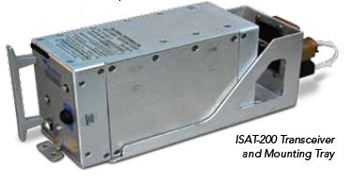
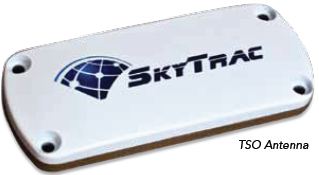
Meluck: There are three key LRUs: the transceiver, mounting tray and antenna. The tray is what is mounted in the aircraft and all other inputs to the system are wired to the tray. The transceiver then connects to everything through the tray. The antenna, of course, connects to the transceiver. Additionally, the end user may opt for a Cockpit Display Panel (CDP), Dispatch Voice Interface (DVI) unit, or a combined CDP/DVI unit (CDU). A Blackberry interface can also be used. These allow for the dialing and receiving of phone calls and the sending of text messages. The ISAT-200 audio is connected directly to the aircraft’s audio panel. All voice goes through the audio panel, crew’s head sets and microphones.
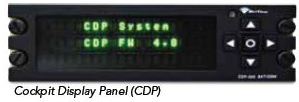

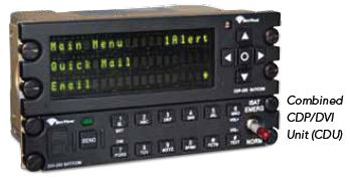
HeliMx: Are the other systems that are connected to the tray digital, analog or a combination of both?
Meluck: They can be analog, digital or both.
HeliMx: The connections to the tray appear to be a function of what type of equipment already exists in the helicopter. An older model helicopter may have more analog inputs, while a newer helicopter may have more digital inputs.
Meluck: Generally, it’s dependent on the equipment connected to the mounting tray. For example, a squat switch usually provides a ground or an open. It’s either on or off, so digital works just fine for that. As for analog, if you’re looking at a range of values for engine monitoring, with the engines running, the oil pressure gauge is providing a voltage that changes with flight conditions. The information on connecting digital and analog inputs would be covered in the applicable STC document package.
HeliMx: One of the things I know from my own experience working with RF systems is that depending on the type of co-ax cable being used, the length of the cable run from the antenna to the transceiver can be very important. How about with the ISAT-200 system?
Meluck: We do have a cable length consideration for the system installation. When using RG 400 Co-ax, the cable run should not exceed 18 feet. In the STC and the ISAT-200 installation documentation, other co-ax cable types are suggested should a cable length greater than 18 feet be required. What has to be maintained is that, regardless of the cable length run, the maximum signal attenuation must be less than 3 db.
HeliMx: Since we’ve been talking about antennas and cable run, you have a single antenna that combines GPS and Satcom functions. Are there any special mounting considerations?
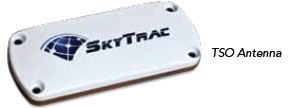
Meluck: The location of where the TSO antenna is mounted is very much a function of where existing antennas are already mounted on the helicopter. The antenna should be mounted as high as possible on the helicopter, on a horizontal plane as much as possible and with as large a view of the sky as possible. It is also recommended that the antenna should not be any closer than three feet from any other GPS antennas. If there is a problem with the three-foot minimum distance, we ask the installer to tell us what antennas are mounted in close proximity and what their power is and transmit/receive frequency. With that information, we can look into what possible interference may occur and get back to the installer with additional mounting information.
Additionally, it is important to make sure that the antenna cables are not crossed to avoid damaging the modem. The Iridium connection on the ISAT (“A1”) must be connected to the TNC post on the antenna. The GPS (“A2”) must be connected to the SMA post.
HeliMx: How would you know about the possibility of interference prior to connecting the antenna? Is there any kind of antenna location survey that is done?
Meluck: Generally speaking, no. Interference is normally based on frequency and radiated power. Depending on the proposed antenna location, this is something that needs to be investigated by the installer. To give a sense of what is acceptable, think in terms of bars in view on a cell phone. For good position data to be sent, one bar needs to be in view. For good voice data, three bars are needed. Transmitting antennas close to the TSO antenna could limit the signal strength and affect voice and data.
HeliMx: Who typically does an installation — SkyTrac, the end user or a third party installer?
Meluck: SkyTrac does not do the physical installations but often advises on the installations, which are typically done by the end user or a third-party installing agency the end user has contracted with. This usually depends on the size and type of operation of the end user. Key to doing the installation successfully is having qualified personnel.
Another very important aspect to an installation, especially if the end user has contracted with a third party installer, is to make certain that the installer not only understands the capabilities of the ISAT-200 system, but also understands what the customer expects in terms of what the system will and will not do when the installation is complete.
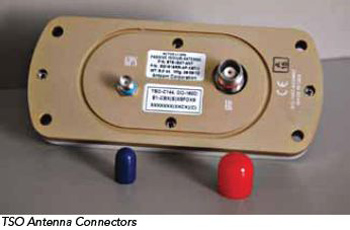
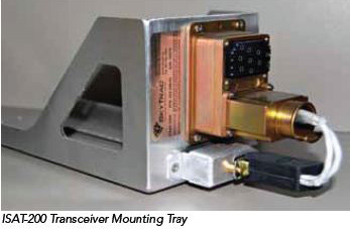
HeliMx: Now that the system is installed, let’s talk about maintaining it. What periodic tests, go/no-go indications and lessons learned can you share with us? As an example, I know that if you remove a radio altimeter transmit antenna for cleaning, you do not want to power on the radio altimeter system with the antenna disconnected. Do we have the same concerns with the ISAT-200 transceiver?
Meluck: With the ISAT-200 system, you definitely do not want to power on the transceiver with the antenna disconnected. It is recommended that if the antenna is disconnected from the transceiver, you should pull the ISAT-200 circuit breaker and tag it not to reset until checking that the antenna has been reconnected.
HeliMx:Let’s go back and talk about the transceiver tray for a moment. Many systems are programmed as to what type of data the system is receiving. Sometimes this is done with programming pins. Sometimes it is done with software through a configuration module. How is this accomplished in the ISAT-200 system?
Meluck: Configuring the ISAT-200 system is accomplished through our online SkyWeb software which sets the configurations in the mounting tray. Once the installation is complete, the installer or end user configures the mounting tray to correspond with the wiring connected to it. The system is powered up and the configuration information is then loaded into the tray through a mounted transceiver. The advantage to this is that the ISAT transceiver itself can be moved from aircraft to aircraft while the actual configuration information resides in the mounting tray.
HeliMx: From the maintenance perspective, when we talk about testing the system, what does the maintenance specialist have to do to verify the system is functional?
Meluck: Once the system has been installed, the first test recommended is what I refer to as an “out of the box” test. Before the system is configured for anything specific, turn the system on outside and see if we can see positional data. This can be accomplished through the SkyWeb software and is often done in collaboration with the end user, or some installers have their own accounts with us. Some installers can do the testing themselves; others give us a call and tell us that they have powered up the system. SkyTrac’s Client Services can verify that they are or are not receiving the helicopter’s position information.
HeliMx: Once the system is initially powered on, what indications does the crew have on the flight deck that the system is functional in all respects?
Meluck: If the crew’s headsets are connected to the audio system and to the ISAT channel in use, they will hear a tone. If they are using a DVI they will see Data Delay and Msg In annunciators flash. If using a CDP or CDU, they will see the embedded software versions followed by the home menu. If there is a problem, they will see error messages displayed on the CDP/CDU or flashing Data Delay on the DVI. If they are using a Blackberry interface, it is a little bit different and amounts to “can I connect or not?”
Power-On Message
HeliMx: Any special tips on maintenance or storage of units, any dos or don’ts or anything to be careful of?
Meluck: The main consideration for long-term storage is the battery in the transceiver. This is a rechargeable lithium ion battery and serves two functions. In normal operation, when the ISAT-200 system is powered down, the battery provides power to transmit the helicopter’s position at the time of power down. The second function is when the ISAT-200 system is placed in the emergency mode. The emergency mode is used under certain conditions determined by the flight crew, and will have the ISAT-200 system continually transmit position date and SkyWeb configured email messages until the battery dies. If the transceiver is not going to be used for a long period of time (several weeks), it is recommended that the battery be removed from the transceiver and stored in a cool, dry environment.
HeliMx: Is the battery field replaceable?
Meluck:Yes.
HeliMx: How about some installation tips on grounds and shields?
Meluck: The ISAT-200 system has special grounds for better signal quality. One of the grounds that often is missed on the installation is the digital ground. The digital ground is connected to the helicopter’s normal ground plane and is the source for all digital inputs requiring a ground. Needless to say, if this ground is overlooked, problems will occur. Shield grounds are also important, especially for the control heads.
Antenna crimping is another area of concern during installation. It is strongly recommended that a crimping tool be used so that a good, clean insulation cut is made, the pin is made to the exact length, and the shielding is intact. This helps maintain the proper signal-to-noise ratio. We have observed in installations where antenna connections were done without a crimping tool that connector pins have either been too long or too short and shields have been damaged, which affects the quality of the signal.
HeliMx: In the installation package, is there a specific tool that is recommended?
Meluck: No, we do not recommend a particular tool by brand name. A crimping tool is typically a normal and routine tool found in the avionics shop.
HeliMx: I know that some equipment when mounted in the aircraft has to be oriented in a particular direction. Typically it might say transceiver handles forward or handles aft. Does that come into play with the mounting tray?
Meluck: No, the mounting tray can be installed in the helicopter so that when the transceiver is mounted in the tray it does not matter which direction the handles are facing. The ISAT-200 does have a menu, accessed via a button and display on the handle side. The system menu allows for testing of inputs and displays of alerts so it is recommended that the handle side be easily visible.
HeliMx: How about some trouble shooting tips? What happens if the GPS fails? Will position information still be transmitted?
Meluck: If the GPS fails but the Iridium connection is valid, positions will be transmitted but there will be no coordinate data. The SkyWeb software will show a No GPS in lieu of the coordinate data. Usually this indicates a fault with the antenna cable going to the GPS side of the antenna. The most common symptom found in helicopter installations is the antenna cable is not connected tight enough, and due to the helicopter’s high vibration environment, the cable has worked itself loose. The recommended corrective action is to disconnect the antenna cable at both ends, and then reconnect them securely to see if that fixes the problem. If that does not fix the problem, the next thing to look at would be the cable connectors (shielding, pin length, etc.) and the cable attenuation. If the installation seems OK, the client would contact SkyTrac Client Services regarding having the unit come in for component testing.
HeliMx: What about voice communication issues? How can you tell if the problem is with the transmit or receive side of the transceiver?
Meluck: In the four years that I have been working field support, I have never seen a system where either just the transmitter or just the receiver was not functioning. Either the communications system works or it doesn’t. There have been instances where people have had problems dialing out, and generally the problem found was that they had not dialed out correctly.
All satellite calls are international in nature. Therefore, when placing a call from the aircraft, you must dial the Iridium international access code which is 00, and then the country code (North America is 1) and then the actual phone number being called. If you are sitting in your office in Phoenix and want to talk to your aircraft that is just on the other side of the airport, you must dial the IDD from the country being dialed from (in the above case, 011), then the full Iridium phone number which starts with 8816 or 8817.
It is important to note that toll-free numbers cannot be reached with a Satcom system, unless they are a global toll-free number. This is important if a customer wants to reach a weather service which is a toll-free service within the country. If it is not a global toll-free number, then a direct phone number must be used.
Another issue that is seen frequently is someone can call you and you hear them, but they cannot hear you. This is usually resolved with a microphone adjustment on the audio panel or on the ISAT-200 transceiver itself.
HeliMx: How about any problems that might be encountered when the helicopter is on the ground as opposed to in the air?
Meluck: Like most systems that are transmitting and receiving RF energy, the local surroundings play a part in how well the system can transmit and receive. Mountains, deep valleys and proximity to metal structures such as a hangar all play a part in how well the system performs. Remember that the ISAT-200 system works best when there is nothing but sky between the ISAT antenna and the satellites. If the helicopter is at an airport in close proximity to other aircraft that may be transmitting on close frequencies and high power, this can interfere with the ISAT-200’s performance.
HeliMx: How about periodic maintenance checks? Are any required?
Meluck: There is no periodic maintenance check required, as long as the system is working as expected. We do recommend testing the system in the emergency mode frequently. This allows clients to confirm position data is being transmitted more frequently and email notifications sent to whoever has been configured to receive them. If there are any concerns with the test, clients should contact SkyTrac’s Client Services.
Typically the Lithium Ion battery in the ISAT-200 has an approximate one- to three-year lifespan, dependent on how the battery/ISAT system is stored, the temperature the system operates in, as well as other factors. If we start seeing missing Mains Off reports, that is a good indication that the battery needs to be replaced. The ISAT-200 display may also show a battery alert. It is best to contact SkyTrac Client Services if a battery issue is suspected.
HeliMx: Tell me about your field support team.
Meluck: Client Services is located in Kelowna, British Columbia, and is open 5 a.m. to 5 p.m., Monday through Friday (PST). The Data Center provides 24/7 support and primarily supports customers that are reporting problems tracking their aircraft.
Typically the end user contacts client services either through our main phone number or via email. Once they have described the problem, we can advise them where to start looking for the fault. We may advise them to check the wiring between two points. It’s possible that the system is configured (software) one way but wired for a different configuration. Once the typical installation checks have been reviewed, we may ask the client to send the transceiver to us so we can perform further diagnostics on it. Experience has shown that a successful installation not only relies on the capabilities of the installing personnel, but properly interpreting the installation documentation. Should any clarification be required, never hesitate to contact our customer support team.
 Shane Meluck
Shane Meluck
Senior Analyst
Client Services Department
SkyTrac Systems
With a background in Computer Engineering and Information Systems, Shane has been providing support for SkyTrac Systems’ clients and installers since the beginning of 2007. He specializes in assisting installers with wiring and system operation questions and troubleshooting, as well as client usage of SkyTrac Systems resource management software and the client’s hardware. He also provides onsite training for many of his clients around the world, which helps them utilize their equipment in a manner more specific to their needs.
